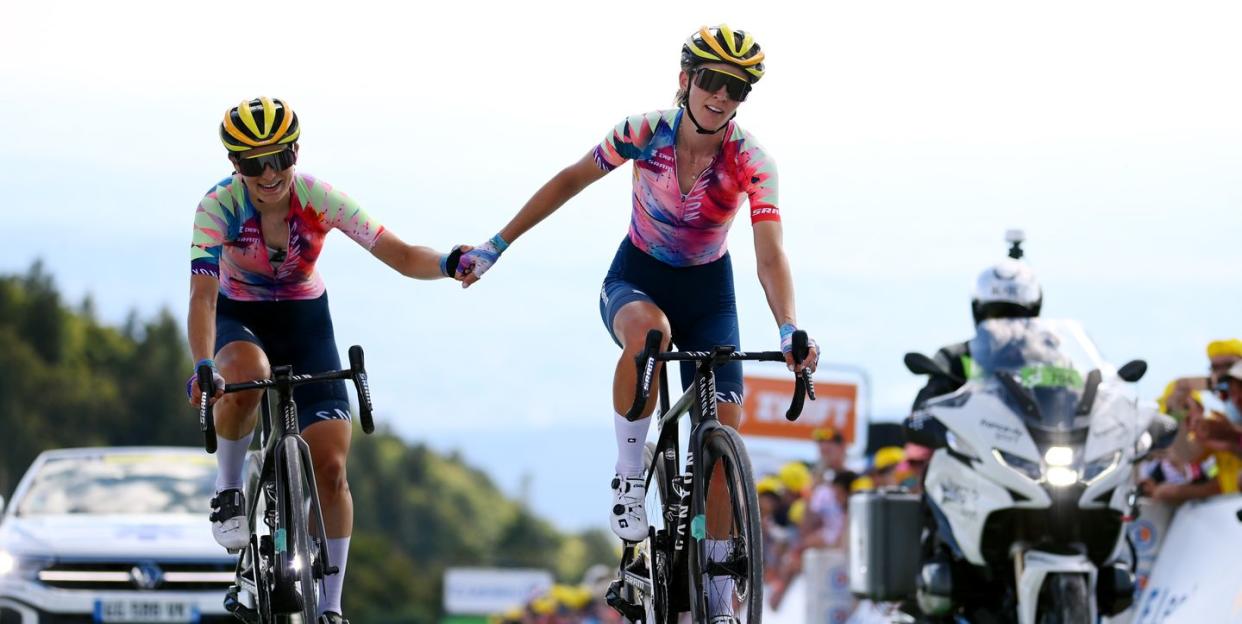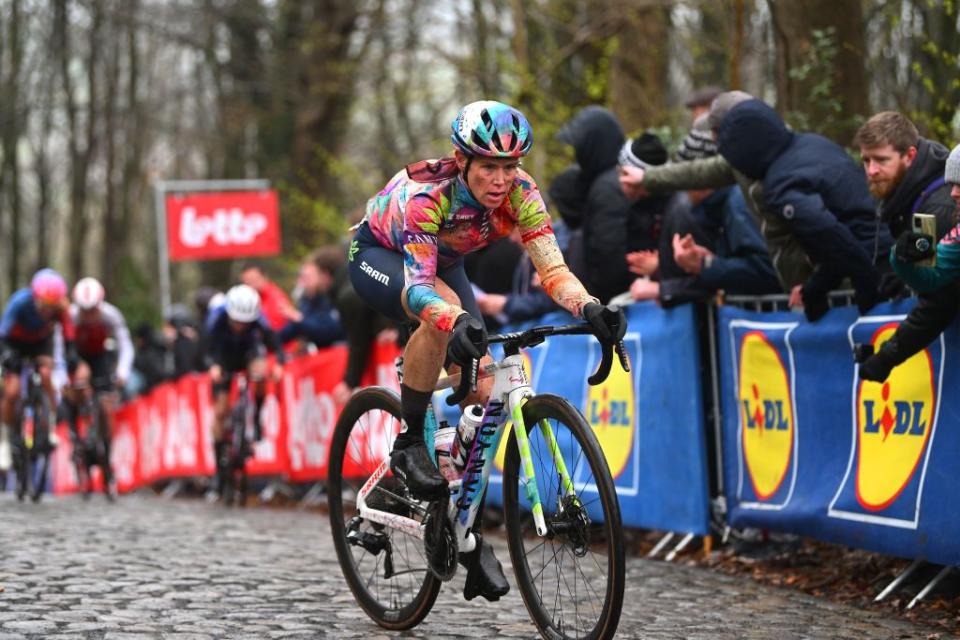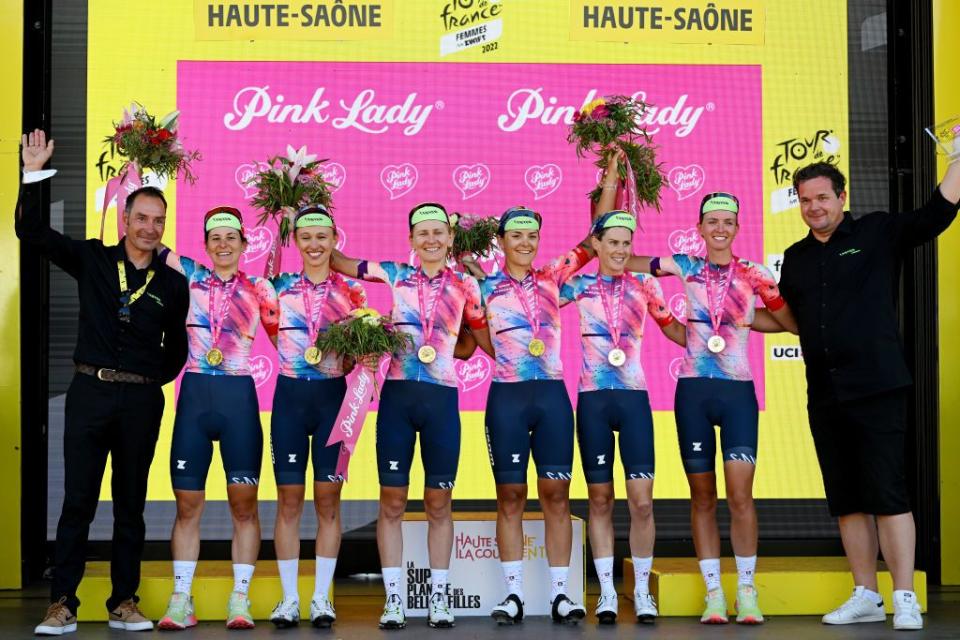The Evolution of Women’s Cycling: The Canyon//SRAM Team and the Building of a Brand

With Paris-Roubaix Femmes avec Zwift just around the corner and under 100 days until the Tour de France Femmes kicks off, there’s a lot of buzz around women’s pro cycling.
What does it take to make a women’s WorldTour team successful for nearly a decade, continuing to grow and evolve as the sport has grown in leaps and bounds through the years?
Here, Beth Duryea, Marketing and Communications Manager (and so much more!) at Canyon//SRAM takes us behind the scenes to see what it takes to make a women’s WorldTour program happen, and how races like Paris Roubaix Femmes and the Tour de France Femmes are changing the landscape for women’s cycling.
How did you end up in pro cycling?
I started in cycling actually quite late, when I was in my mid-twenties. I was a physiotherapist and I was doing my Master’s in sports physiotherapy. And with that, I needed to do clinical hours. I came from a running background, but I worked with a guy who was very into cycling. He kept telling me I should take up cycling and stop running. I distinctly remember telling him, ‘There’s no way you can pay me to wear lycra right on the road.’ But of course, I fell in love with it. So, never say never basically. But I came to pro cycling while I was in that program—I did some clinical hours with one of the top physiotherapists with the Australian Institute of Sport, and they had their base in Italy then, where they were doing a lot of work with cyclists. I did three months there and loved it—so much that when a full-time job came up there, I took it. I was there working with the Australian Institute of Sport as a physio predominantly in road cycling, but also a little bit of track and with athletes from juniors to elite women to elite men. After that, I left to start working with pro teams and started working with Ronnie Lauke, who eventually became the co-founder for Canyon-SRAM with me.
How did that happen?
I worked with Ronnie at Specialized Lululemon as a soigneur for three years, but as I was doing that, I was also doing other roles within the team. I was doing logistics and worked as the sport director for a few races. We worked on that team and then another team, but they ran into issues and fell apart, so suddenly, we and a lot of riders didn’t have jobs. Luckily, the connection to Canyon was made, and they had been looking to start a women’s team but they hadn’t really found the right setup or the right people. And things lined up, and we were able to start the team in 2015.
You started as a physio, became a sport director, and now you’re managing communications: With women’s teams, is that kind of evolution common, where you wear different hats depending on the need?
Your skill set improves quite rapidly when you work in women’s cycling! You do wear many different hats and you can see it as a positive or a negative. In my case, now I’m doing marketing communications around the social channels for the team. It’s nothing I studied at university, but I had the opportunity to learn those skills just from being involved in cycling teams and from having an interest in it. If you’re working with women’s teams, it does give you more opportunity to follow your interests as they shift, but some people wouldn’t find that very comfortable.
Are you seeing more women in staff roles on women’s teams now compared to when you started?
For sure. In general there are more and more women in cycling now. When I first started, most of the female staff were in the role of physio or soigneur. As I started doing a bit of sport directing work, there were one or two other female sport directors. But now when you go to a race, it’s close to 50-50. There’s a significant number of women involved in all aspects of the sport now.
Canyon//SRAM has become a well-known ‘brand’ in women’s cycling. What differentiates your team from others?
That’s nice to hear! It’s not necessarily one thing: I know that when we started the team, we wanted to make the women’s side of the sport more visible, and to start something that was not was not around before. We were lucky that our main partners were reputable cycling brands that were investing into the women’s side of the sport. So that helped us grow. But I think that we went into it with the idea of creating our own brand regardless of who the sponsors are or were. And although the team name has remained the same, we continue to push having different designs, different riders, different team structures.

You’re also one of the few standalone women’s teams: Is that a benefit or does it cost you?
It’s something unique, being a standalone women’s team. Because we don’t run alongside a men’s team, we don’t benefit from the same infrastructure that the longer-lived men’s teams can provide to the women’s teams. But at the same time, we also show that you don’t need to rely on what was or has been traditional in cycling.
You’ve also had some extremely non-traditional riders—is that part of the brand?
We tried to look at the traditional sport of cycling with a bit more of a modern or forward thinking mindset. So being really open to doing initiatives has always been important for us. We started Zwift Academy in 2016. At the time, people laughed at the idea that a team would do talent ID from an online training platform. And now, we’re in our seventh year of Zwift Academy, and there’s a men’s version as well with another team. But when you look at that, if we’d tried to keep that traditional cycling mindset, we would have missed that great opportunity. The willingness to consider new innovations like that is important to us. More recently, we became the first women’s WorldTour team to have a two-tier structure for a development team. We did this so we could ensure that we were able to look for riders in countries where pro cycling isn’t as easily accessible for women. As a woman, there are a lot more barriers to get into the sport, and even more so if you’re not from the main countries that are represented in pro cycling. We specifically wanted to make sure that we were trying to recruit riders from the countries that were underrepresented and help reduce the barriers for them as well.
The Tour de France Femmes avec Zwift is another example of innovation that seemed ‘impossible’ if you asked traditional cyclists, but it was huge last year. How did it feel winning the team GC?
The Tour de France Femmes was special in itself, as was getting our rider, Kasia Niewiadoma, on the overall podium in third. But for the team as a whole, when you have the opportunity for the whole team to get on to the podium, it’s always special. That race became clearly the biggest race of the women’s calendar, almost in an instant. There were a few tears shed on that final day.

To get third in the GC and the overall team GC is a big accomplishment—is the team GC something many teams strive for?
Of course, I’m not privy to the insights of every single team and what their goals were, whether they had individual goals for stage wins or GC goals or particular jerseys. But I think if you’re aiming for a rider to finish at the top of the final GC, then you need to have a team that is able to support that leader right up until the end, and that means you have to have numbers [of riders towards the front supporting the leader] right into the end. So I think it goes hand in hand.
How do you think the TDFF has changed women’s cycling?
From the moment it was announced, people—whether you’re inside or outside of the sport—realized how big of an opportunity and how big of an event it was. We knew it had the power to transform the sport. And I also knew that it would change the landscape for us: I was ready for the fact that we would have so much attention and so many requests leading up to the race. Women’s cycling hadn’t seen that on any level before. It blew our minds, the excitement and the hype around it. And then, the actual racing was really exciting to watch. I’m sure that brought new fans to the sport and those fans are really looking forward to the race again this year. We see them paying more attention to how the team is doing even now.
And what do you think it will do for the future of the sport?
Personally, I believe we’ll see a big increase from year to year in terms of fans coming to the sport. But I’m really excited to see a little bit further down the track what happens in terms of the riders. There will be young girls who have now seen the race on TV, and may decide, ‘That’s what I want to do.’ In ten years, as riders are being interviewed, I want to hear them say, ‘I was watching the Tour de France Femmes on TV and wanted to do that.’
The women’s iteration of the Paris-Roubaix race was added before TDFF started: Do you think that helped push ASO to make the women’s Tour de France happen?
Zwift has been such a big part of this growth. The Paris Roubaix avec Zwift women’s race already was a big step. And it showed that women were able to do that sort of race and that people wanted to watch it. From a team perspective, races like Paris-Roubaix are so challenging logistically, but that’s what makes them so unique. Having Zwift support both of these races ensures that the level is high—and having them as co-sponsor encourages ASO to put the same effort into the Tour de France Femmes avec Zwift as they do to the men’s event. And I think with this combined effort, plus all of the media and the riders themselves keeping this momentum moving forward has made this such an exciting time for women’s cycling.
You Might Also Like

